Paris during World War 2
Paris during World War 2 : The German army entered Paris, which had been declared an open city, on 14 June 1940 and took possession of it. On 18 June, the triumphal parade on the Champs-Élysées/ Avenue Foch with 10,000 soldiers was filmed by German propaganda. The occupancy apparatus was quickly set up. On 22 June 1940, the armistice was concluded between the German Third Reich and French representatives such as Philippe Pétain in Compiègne. During 4 years Paris becomes German.
Paris Highlights During World War 2
Discover the rich and poignant history of World War II in Paris with a comprehensive private driving tour. This tour is designed to cover Paris’s major WWII sites, offering an in-depth exploration of the city’s involvement during this critical time in history.
- From €850 – USD $885 up to 6 persons upon level of customization
- Private 4-hour city tour by car with Stops at Paris Iconic Highlights
- Duration: Typically 4–6 hours, depending on your preferences
- Availability: Offered year-round, with flexible start times.
- Pick-Up/Drop-Off: Convenient pick-up from your hotel or central location in Paris.
This private tour combines history, convenience, and a deep connection to the past, offering an unforgettable journey through one of the most significant periods in Parisian history.
Major Parisian Sites during World War 2
- Place de la Concorde: Learn about the events that unfolded during the occupation.
- Invalides: Visit the Army Museum and delve into the military history of France.
- Le Marais: Explore the Jewish Quarter and hear stories of the Holocaust and the French Resistance.
- The Eiffel Tower Area: Understand its symbolic significance during the war.
- Rue Lauriston: A site linked to the Gestapo headquarters.
As a private tour, the experience is tailored to your interests. Whether you’re a history enthusiast or want to explore family connections to WWII, PARIS BY EMY will adapt the itinerary.
Paris Private Tours by Car Service
| Pricing | Duration | Features | Location | Passengers |
|---|---|---|---|---|
| From 580 € | 4 hours | Driver only | Paris | 1 to 7 |
| From 850 € | 4 hours | Guide+driver | Paris | 1 to 6 |
| From 1,180 € | 6 hours | Guide+driver | Paris | 1 to 6 |
| From 1,450 € | 6 hours | Guide+driver+museum | Paris | 1 to 6 |
| From 1,650 € | 8 hours | Guide+driver | Champagne | 1 to 6 |
| From 1,850 € | 12 hours | Guide+driver | Normandy | 1 to 6 |
| Quote | X hours | Your choice | Your choice | Your choice |
Custom Private Tours Driver in Option
Hotel, hospital, military school in Paris during World War 2
When the Germans arrived by the North of Paris at 6am up to the Arc de Triomphe, Paris is quiet, a dead city. Out of 1.8 millions of Parisians, 1 millions left Paris. The Wehrmacht is in total power. The Wehrmacht were the unified armed forces of Nazi Germany from 1935 to 1945. It consisted of the Heer (army), the Kriegsmarine (navy) and the Luftwaffe (air force).
During summer 1940, the soldiers behave like tourists, they discover Paris, perfumes, department stores such as Les Galeries Lafayettes, wines. They send agricultural production to Germany. They loot the works of art of Jewish families. Hitler decides to make brothels available to officers and soldiers. The Germans organized leisure activities, sport events, restaurants (Maxim’s, La Mère Catherine), cabarets (Lido, Moulin Rouge) only for the German army.
The Berlin Philharmonic plays at the Théâtre du Palais de Chaillot. The Protestant choir sings Bach at Notre Dame in front of the Wehrmacht. The Germans chose hotels to establish their offices thanks to the Michelin guide. 400 hotels among them top luxury palaces :
Le Meurice – Paris during World War 2
During the Occupation, between September 1940 and August 1944, the Hôtel Le Meurice served both as the headquarters of the German military command of the Paris garrison and as official accommodation for the five military governors.
- Alfred von Vollard-Bockelberg (juin 1940)
- Kurt von Briesen (septembre 1940)
- Ernst Schaumburg (nov 1940 / 28 juil 1943)
- Hans von Boineburg-Lengsfeld (août 1943/ 7 août 1944)
Le Ritz – Paris during World War 2
In the opulent suites and state rooms sat Wehrmacht officers, collaborators, spies and privileged jet-set people who were spared the armed conflict rubbed shoulders. Unlike some of the capital’s large hotels, the Ritz remained open during the Occupation because the owners, César and Marie-Louise Ritz, their associates and the executives were Swiss, i.e. neutral, not engaged in the war. Although Hitler was not seen inside the Ritz, Hermann Göring, a morphine addict, lived in the imperial suite and added to his collection of jewellery and paintings every day. He was one of the most powerful figures in the Nazi Party, which ruled Germany from 1933 to 1945.
Le Lutetia – Paris during World War 2
During the Second World War, the establishment was requisitioned by the Abwehr, the German intelligence and counter-espionage service, before welcoming survivors of Nazi concentration camps at the Liberation.
Le Majestic (now The Peninsula hotel) – Paris during World War 2
During World War II and the Occupation of Paris, from October 1940 to July 1944, the Hotel Majestic was occupied by the headquarters of the German military high command in France, Militärbefehlshaber in Frankreich (MBF) led by Generals and cousins Otto and Carl-Heinrich von Stülpnagel.
The Germans also took over buildings, and appartments but also hospital, military schools and military barracks. Road signs are changed with German names. Paris becomes the warrior’s rest town. It is the cultural choc.
In addition, for the Germans, Paris was like a reward for the soldier who fights in Russia and North Africa. The Battle of Stalingrad (23 August 1942 – 2 February 1943) was a major battle on the Eastern Front of World War II where Nazi and its allies unsuccessfully fought the Soviet Union for control of Stalingrad in Southern Russia.
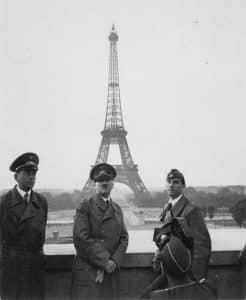
Hitler’s Paris visit during World War 2
The German army entered Paris, which had been declared an open city, on 14 June 1940 and took possession of it. It was therefore in the early morning of June 23 or 28, 1940 for a lightning visit (“Blitz Besuch”). Hitler began his tour at 6 a.m. and ended at 8:15 a.m. Hitler came once to Paris. He had to see :
1. Montmartre Sacred Heart Basilica (he hated the basilica)
2. Place de l’Opéra Garnier
3. Place de la Madeleine
4. Place de la Concorde and national assembly
5. Arc de Triomphe – Avenue Foch – 93 rue Lauriston (French Gestapo headquarter)
6. Place du Trocadéro
7. Eiffel Tower
8. Les Invalides army museum (to see Napoleon’s Tomb)
9. Pantheon
10. Notre Dame
11. Place des Vosges
12. Louvre Museum – depot where works stolen from wealthy Jews transit and where Reichsmarschall Hermann Göring himself comes as on May 3, 1941 to choose pieces that will adorn his residences
The newsreel and photographs immortalize the German victory that ends the Battle of France. Like the lightning war it crowns, the lightning visit deploys a military gesture whose efficiency, rigor and organization it symbolizes.
The Resistance in Paris during World War 2
Between 1940 and 1945, during the Second World War, the “resistance fighters” were the men and women who fought clandestinely against Adolf Hitler. In France, the resistance was born with the appeal of June 18, launched from London by General de Gaulle. It ended with the liberation of Paris and France in August 1944.
Joining the resistance is then a decision fraught with consequences, for which many have paid with their lives. In retaliation for attacks committed in Paris on September 16th 1942 (including that of the Rex cinema where three enemy soldiers died), the German authorities decided to shoot 116 hostages.
The Choice to Oppose Nazi Germany
Resistance to the invader appeared in many German-occupied countries, including France, Poland, Yugoslavia, Greece, Belgium — but also in Italy against the fascist regime of Benito Mussolini. In France, this clandestine struggle was waged both against the German occupier and against the Vichy-installed French government (collaborating with Germany).
In the countries invaded by Nazi Germany, each individual reacted differently to this occupation depending on his personality, his past, his convictions, sometimes also according to his encounters. While the majority of the occupied populations simply sought to get through this ordeal by living discreetly, some began to collaborate with the victors (these were the collaborators) and others decided to continue the fight against the enemy (these were the resistance fighters).
Resistance fighters were men and women of all ages and backgrounds who chose to refuse, disobey and resist Nazi Germany. And it is often simply by discussing between relatives (friends, neighbours, colleagues) who share the same opinions, that the first resistance networks are created.
Communist group and Gaullist networks in Paris during World War 2
In 1940, the networks and movements of the Resistance were very informal and unstructured: there were groups in the free zone and others in the occupied zone; communist groups and Gaullist networks; an internal resistance (which acts in France) and a resistance that acts from abroad (the Free French Forces or FFL, formed by General de Gaulle and which fight alongside the Allies). Gradually, the FFL and the inner resistance come into contact and work together.
In 1942, Jean Moulin brought these movements together to form the United Resistance Movements, whose military wing was the Secret Army. Then, in 1943, General de Gaulle was recognized as the leader of the internal resistance, unified within the National Council of the Resistance (CNR). Finally, in 1944, the French Forces of the Interior (FFI) were created, bringing together all the armed forces under the command of General de Gaulle.
Forms and means of Active Resistance
The Active Resistance, with a capital letter engages in different types of activities: intelligence to prepare armed actions, propaganda to recruit new resistance fighters and circulate information, armed action and acts of sabotage.
- Distributing a leaflet
- broadcasting information heard on Radio London
- Printing or distributing underground newspapers
- Hiding Jews
- Sheltering English airmen
- Helping someone to cross the demarcation line
- Drawing on a wall a cross of Lorraine (the symbol of General de Gaulle)
- Going to demonstrate on the National Day (July 14)
- Making false papers
- Hiding weapons
- Disseminating military intelligence
- Blowing up a train or factory that collaborates with the Germans
- Sabotaging German equipment…
Resistance fighters received weapons parachuted by British airmen, but also had to find them by their own means: for example, by attacking arms and ammunition depots (Germans or the disbanded French army), or by attacking French policemen to take their service weapons. In the spring of 1944, before “D-Day”, Allied parachute drops armed around 120,000 men. In 1944, the resistance fighters were informed of the imminent landing of Allied troops. They then participated in the dissemination of false information for the Germans; they multiply sabotage (trains, railway lines, telephone and telegraph lines, power lines); They cut off the roads, making it difficult for German reinforcements to arrive. These very important actions all prepared the Allied offensive for the Normandy landings (June 6, 1944, known as “D-Day”).
The Resistance’s Means of Communication
Those who are fortunate enough to have a radio set listen to the French-language programs of Radio-Londres (notably Les Français parle aux Français) and then talk about it around them.
The BBC (the English radio) informs them about the conflict in the world, but also about what is happening in the world. It is also the one who gives instructions to the various networks of resistance fighters, through coded messages.
Leaflets and underground newspapers are another source of information. But to do this, you need paper, ink, and well-hidden printing equipment; These clandestine documents must then be distributed and circulated.
Every movement has its own journal. More than 200 underground newspapers appeared in France during the occupation, some regularly (1 to 2 times a month), and their circulations ranged from a few thousand copies to more than 400,000 in 1944.
The perilous daily life of the resistance fighters
Part of the Resistance was made up of men and women who went underground. They form maquis, which are real armies hidden in the forests and mountains. A maquis can bring together several hundred men, supervised by a military hierarchy.
- A large part of the maquis was made up of men who resisted the STO (the Compulsory Labour Service), which required able-bodied French people to go and work in Germany) and those who were wanted by the Germans or by the French police.
- Other resistance fighters remain in their cities or regions to carry out their actions under a false identity, with false papers (sometimes obtained thanks to the complicity of city officials). They chose a pseudonym for themselves as a fighter: for example, the members of Jean Moulin’s network only knew him as “Max”.
June 22 of 1941, Russia is invaded by Germany. In Paris, a soldier of the German Navy, midshipman Alfons Moser, was killed by a young communist, Pierre Georges (known as Colonel Fabien), on August 21, 1941, at the Barbès – Rochechouart Paris metro station. The Germans killed 100 hostages for 1 killed German.
Resistance in Paris during World War 2
It is estimated that of the approximately 200,000 resistance fighters active in France during these four years (1940-1944). More than 60,000 died during the fighting, in deportation or executed.
In 1958, a French Resistance memorial was erected on Mont Valérien (in Suresnes, west of Paris) to honour the memory of the 4,500 resistance fighters. The Nazis executed there those fighters during the Second World War.
Resistance fighter, German Gestapo and the French Militia
A resistance fighter must always remain on his guard, and never reveal himself so as not to be unmasked and denounced. When a resistance fighter was arrested by the German Gestapo or the French Militia, he was interrogated and tortured.
They try by all means to get him to talk to get information about his network. This is the reason why a resistance fighter never knows all the members of his network. Moreover, he/she is instructed to “hold” for 48 hours, the time for his comrades to change hideouts, to “disappear”. After being tortured, he was imprisoned, then quickly deported to a concentration camp in Germany, or shot in France.
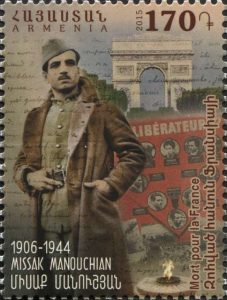
The recent pantheonization of Missak Manouchian
The hero shot by the Germans in 1944, the first foreign resistance fighter, Armenian and communist, to enter the Paris Pantheon. He will be accompanied by his wife, Mélinée. The decision was made official on Sunday, June 18, by the Elysée. The ceremony took place on February 21, 2024, on the 80th anniversary of the death of the hero of the Resistance. The German shot him on the hill of Mont-Valérien, alongside 24 other members of the Resistance, including 21 members, like him, of the Francs-tireurs et partisans de la main-d’œuvre immigrée (FTP-MOI).
“Missak Manouchian chose France twice, by his will as a young Armenian man in love with Baudelaire and Victor Hugo, then by his blood shed for our country,” explains the Elysee, hailing the “quiet heroism” of the resistant.
Missak Manouchian, an orphan of the Armenian genocide of 1915, has entered the Pantheon, 80 years after he was shot by the Germans. He will be laid to rest there with his wife, Mélinée. She, too, had fought against the Occupation.
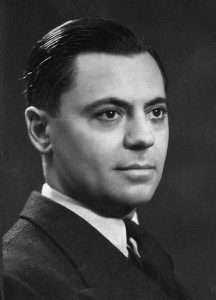
Jean Moulin
In the French national memory, Jean Moulin remains the charismatic figure of the internal Resistance to Nazi Germany. As head of the National Council of the Resistance (CNR), he was arrested and tortured, but died without revealing any secrets.
ACTION IN THE SERVICE OF THE RESISTANCE
Dismissed in November 1940 by the Vichy government, Jean Moulin went to Paris, then to the southern zone, where, for a year, under the name of Joseph Mercier, he sought to make contact with the first resistance fighters. He then went to London, where he placed himself at the disposal of General de Gaulle, whom he met on 25 October 1941.
UNIFICATION OF RESISTANCE MOVEMENTS IN SOUTHERN ZONE
Charged by the latter with coordinating the action of the Resistance movements in the southern zone, he was parachuted near Salon-de-Provence on 1 January 1942. He succeeded in convincing the leaders of the three major movements in this area – Henri Frenay, creator of Combat, Emmanuel d’Astier de La Vigerie, who founded Libération-Sud and Jean-Pierre Lévy (1911-1996) at the head of Franc-Tireur – to separate military action from political action and thus merge their paramilitary elements into a secret army under the command of General Charles Delestraint; then, later, to form the unified movements of the Resistance.
At the same time, Jean Moulin created the General Study Committee (CGE), responsible for preparing the legislative and administrative measures to be taken at the time of liberation. Totally destitute – without a liaison officer, without a typist, without a secretary – encrypting or deciphering telegrams himself, preparing his appointments and exposing himself to considerable risks, Jean Moulin asked Daniel Cordier, whom he met on 1 August 1942, to act as his secretary.CREATION OF RESISTANCE NATIONAL COUNCIL (27 MAY 1943)
General delegate of the National Committee in occupied France, Moulin, who called himself Régis, then Rex and Max – to retain only a few of his pseudonyms – had credits and means of transmission. He set up a veritable clandestine administration of the Resistance and from then on became the obligatory intermediary between the internal Resistance and General de Gaulle, whose authority he had accepted. On 27 May 1943, at his home in Paris on the rue du Four, he presided over the first National Council of the Resistance (CNR), which in his eyes should be the reflection of the broadest national unity. Not without difficulty, he managed to be admitted as head of the CNR, which brought together the leaders of all the French resistance groups.
CAPTURED BY THE SS
A few days later, on June 9, 1943, General Delestraint, head of the Secret Army, was arrested by the Germans. To take the necessary measures, Jean Moulin summoned the leaders of the Resistance to the southern zone. But, following a probable betrayal, he was captured by an SS commando during a meeting in Caluire (21 June 1943).
DEATH AS A HERO
Taken to the Gestapo in Lyon with other resistance fighters, he was quickly identified as Max, the leader of the French Resistance.
“I didn’t know it was so easy to do your duty when you’re in danger,” said Jean Moulin. In the face of his torturers, he showed exemplary courage. Transported to Neuilly, he died as a result of his abuse during his deportation to Germany.THE NATION’S TRIBUTE
He was then replaced by the Christian Democrat Georges Bidault at the head of the CNR. The Gaullists would soon make Jean Moulin one of their heroes. And by transferring his ashes to the Pantheon on December 19, 1964, the Republic granted him an extraordinary status in the national memory. Just as Leclerc entered the Invalides, with his procession of exaltation in the sun of Africa and the battles of Alsace, enter here, Jean Moulin, with your terrible procession,” declared André Malraux during his solemn tribute.
Paris Jewish population during World War 2
Since September 1940, a series of measures had been taken to identify, plunder, isolate and discriminate against the Jewish population. The censuses and spoliation of property, imposed by the first ordinance of September 1940, were followed by occupational discrimination and social exclusion. Prohibitions are multiplying: the possession of wireless radio sets, participation in assize courts. The Sixth Ordinance, in February 1942, forbade Jews from going out between 8 p.m. and 6 a.m., as well as from changing their residence.
The yellow star
The ordinance of June 7, 1942 stipulated that Jews over the age of 6 were required to wear a yellow star in public places. It’s a Sunday: that’s why many Parisians will be confronted with this new anti-Semitic brand the very next day, Monday, June 8. This anti-Semitic discrimination was the brainchild of Adolf Hitler’s propaganda minister, Joseph Goebbels. It was first implemented in Poland in the fall of 1939, where the Nazis forced Jews to wear a white armband with a blue Star of David. This anti-Semitic discrimination was the brainchild of Adolf Hitler’s propaganda minister, Joseph Goebbels. It was first implemented in Poland in the fall of 1939, where the Nazis forced Jews to wear a white armband with a blue Star of David.
René Bousquet the collaborater
René Bousquet was a high-ranking French political appointee who served as secretary general to the Vichy French police from May 1942 to 31 December 1943. July, 1942 René Bousquet is closely associated with the organization of the arrests of foreign Jews in the northern and southern zones. He negotiated their deportation with Karl Oberg, supreme commander of the SS and the German police in France. From 18 April 1942 to 31 December 1943, under the government of Pierre Laval, he was Secretary General of the Police. He behaved like the Director General of the National Police. This structure was created on 23 April 1941 by a law of the Vichy regime.
He was the main organizer of the Vélodrome d’Hiver roundup of 16 and 17 July 1942 and those of August 1942 in the southern zone. Moreover, he also led the French police alongside the occupying forces during the Marseille roundup in January 1943.
In total, more than 60,000 Jews were arrested by or with the assistance of the French police to be handed over to the Nazi authorities. The Nazi organized their “deportation to the East,” to the Auschwitz extermination camp. Vichy was not unaware of the real purpose of the deportations; René Bousquet showed no interest in the fate of the deported Jews.
Paris population during World War 2
Food restrictions
In 4 years, the Parisian population lost 4 to 8 kilos (from 8 to 17 pounds). Nutritional deficiencies affect the growth of children and tuberculosis took its toll. Fear was also a siren that sounds, sometimes several times in the middle of the night. It would force families to go down into the deepest cellars or metro stations, converted into air raid shelters. Spared initially. The city is now the target of increasing Allied bombings.
Since the start of the war, the main resources have been requisitioned by the occupier. The population has had to deal with intensifying food restrictions. They are materialized by ration cards to which tickets are attached setting the quantity of foodstuffs authorized, according to its category.
Getting around by bicycle
With the shortage of fuel, requisitioned for German vehicles, the automobile disappeared. Other means of transportation emerged, changing the face and sounds of Paris. For the mass of Parisians deprived of buses and cars.
The most common way of getting around was by bicycle (which must be registered), bicycle taxi and metro.
The civilian workforce
In 1943, 11 million men served in the Wehrmacht, whose losses (killed, wounded, missing and prisoners) were 4 million. Indeed, the Germans conscripted Soviets as auxiliaries, so that, taking into account their “allies”, 25% of the personnel on the Eastern Front were foreigners. The civilian workforce comprises 30 million people, 8 million of whom are in industry.
In 1944, Sauckel brought 6.3 million foreign workers (including 723,000 French) back to the Reich under the Compulsory Labour Service (STO). Their work was in addition to that of more than 2 million prisoners of war and also to that of concentration camp deportees.
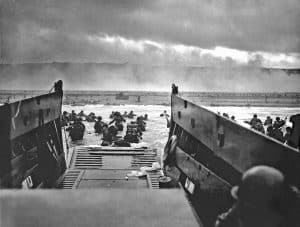
1944 The Normandy landings
This was the assault phase of a larger operation to create a large-scale Allied beachhead in northwestern Europe, and to open a new front in the west. These landings marked the beginning of Operation Overlord, the code name for the Battle of Normandy.
Landing of Americans, English and Canadians
At the beginning of June 1944, in the days leading up to the Allied landings in Normandy (6 June). Hundreds of coded messages were broadcast throughout the day on the BBC. The London radio station was listened to by the French Resistance. Each one is addressed to a particular network. Each has a very specific meaning. “Gentlemen, make your bets” is a sabotage order issued on June 5, 1944 (the day before the Allied landings in Normandy). “The carrots are cooked”, “The dice are on the table” or “The long sobs of the violins of autumn” announced, each to a network of resistance fighters, the imminent landing of the Allies. However, obviously neither the date nor the place.
June 6th of 1944 landing of Americans, English and Canadians in Normandy 250km from Paris. Every moment was precious to Hitler to strengthen his new line of defense (Abbeville-Dijon-Dôle-Swiss border). This was to drive all the Allied armies back to the English Channel. It allows the Wehrmacht to return to Paris. von Choltitz had a great sense of gentleness. This is precisely why Hitler chose him, in 1944, to replace Boineburg-Lengsfeld as the Paris command post. However, the allies are advancing too fast. The Germans in Paris start to return to Germany.
Paris, brûle-t-il? Is Paris burning?
No evidence Hitler asked to destroy Paris
There is actually no evidence that Hitler asked to destroy Paris despite of von Choltitz and the Swedish ambassador sayings. Both General von Choltitz and the Swedish ambassador Raoul Nordling did not really succeed in imposing their accounts. Raoul Nordling worked hard to erase the memory of Sweden’s aid to Germany on the Eastern Front.
As for von Choltitz, the grateful Capital then erected a statue of him near the Gare Saint-Lazare. He published his memoirs everywhere, without much thought to the general’s worries during his captivity. Indeed, he feared that he would have to answer to an Allied Court of Justice for his crimes. And even a purely Soviet Court!
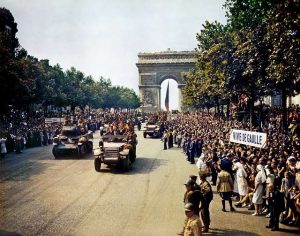
Liberation of Paris
August 19th, insurrections in Paris. Hitler asks to defend Paris while most of the soldiers are in Normandy. August 23rd, Leclerc General arrives in Paris. The liberation of Paris took place from August 19 to 25, 1944, marking the end of the Battle of Paris. This episode took place in the Liberation and put an end to four years of occupation of the French capital. Amen !
Enjoy a Paris driving tour on Paris during World War 2. We can push it very high, up to Normandy Omaha landing beach.

